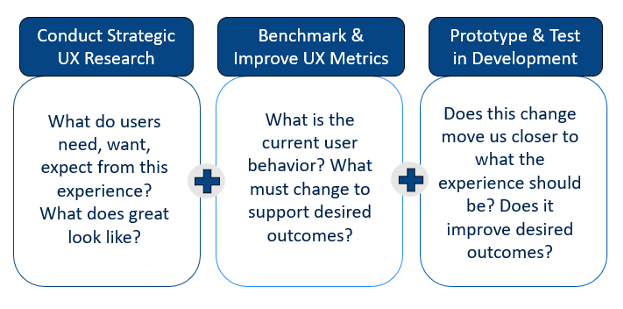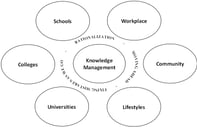Published on
The Importance of UX in Scaled Online Education

Southern New Hampshire University’s (SNHU) mission is to expand access to education by creating high-quality, affordable and innovative pathways to meet each learner’s unique needs. SNHU’ Global Campus is one of the largest providers of online education in the United States, with over 200,000 online learners, more than 200 unique program offerings and a vast technology ecosystem. When educational platforms, tools and resources are thoughtfully designed with user experience (UX) principles in mind, students are more likely to engage actively and meaningfully with the content. Improving usability, usefulness and ease of use (components of UX) within the online learning experience, is likely to improve student adoption and engagement, which can improve outcomes (Ghapanchi et al., 2020; Kizilcec et al., 2017). Intuitive interfaces and clear navigation enhance accessibility and reduce cognitive load, empowering students to focus on mastering concepts rather than struggling with technology.
Online environments are often unnecessarily complicated, and poor design leads to emotional distress and frustration (Granić, 2008; Norman, 2010). Today’s learners have less tolerance for difficult online experiences (Soares et al., 2022) and more choice of providers than ever before. In a global study, the XM Institute (2024) found that consumers cut spending after experiencing a single negative interaction with an organization. Declining customer feedback response rates are compounding this issue, making it difficult for organizations to identify the breadth of opportunities to better support learners. These realities are significant in scaled online education, where poor design can unintentionally create barriers for thousands of learners. When every touchpoint matters to the student success, investing in user experience research and design is not only necessary but good business.
A study of 863 design projects that included usability activities found that allocating 10% of a development project’s budget to usability resulted in a remarkable 135% increase in desired user experience metrics (Nielsen, 2003). This finding underscores the profound impact of user-centered design on outcomes. By dedicating resources to user experience research and design, scaled providers of online higher education can prioritize creating intuitive interfaces, seamless navigation and engaging experiences that resonate with learners. Prioritizing user experience within development projects not only yields tangible improvements in metrics such as conversion rates, engagement and retention but also fosters long-term success by ensuring products and services meet their target audience’s evolving needs and expectations.
In 2019, SNHU began investing in a user experience research and design (UX) function that has steadily been integrated into product development processes across the university. Starting an online degree program requires learning many new technologies and comes with a high cognitive load, which can present early barriers and impact a learner’s sense of belonging and motivation to continue if not thoughtfully designed. This effect is amplified when learners have limited experience with online education, as is the case for the majority of SNHU’s enrolled students. Momentum for UX integration grew when we identified that learners who submit an IT help desk ticket typically have lower success rates in their first-term courses. To ensure a seamless experience for our students, faculty and staff, SNHU has implemented a UX function with three core objectives as seen in figure 1.

Below are examples of how SNHU has put these objectives into practice.
Conduct Strategic User Research
In 2023, the UX team identified an opportunity to improve the course homepage within the learning management system. UX researchers conducted a usability study to thoroughly identify issues in the current experience. They also held student interviews with a representative student sample to learn what students want, need and expect from the course homepage experience. They then ran collaborative design sessions with enrolled students and designed a new course homepage to increase usability and surface useful and relevant resources. Leveraging these findings, UX designers built wireframes and user flows, and they worked with the vendor partner to implement the redesigned course homepage, which almost 200,000 students can now access.
Benchmark and Improve UX Metrics
Benchmarking UX metrics across online platforms and experiences is crucial for identifying specific problems and tracking the impact of changes and improvements over time. The UX team is implementing several metrics including the system usability scale (SUS), user effort score (UES), customer satisfaction (CSAT), task success rate, time on task, error rate, conversion/bounce rate and navigation metrics. UX metrics shine a spotlight on areas where the online experience falls short or excels. This data-supported decision-making enables SNHU product teams to invest in improving the online experience in areas that can make the biggest impact on our learners and desired outcomes. Tracking UX metrics over time enables the team to measure intervention and redesign effectiveness and make tangible improvements in key metrics.
Prototype & Test Within Product Development
In 2023, the UX team embarked on its largest research and testing endeavor to date. A redesigned general education program, including 18 new courses, was being developed. The team hired a diverse and representative group of enrolled students with the support of the Student Employment Office. Once the courses were developed, students worked through various components of the courses, providing detailed feedback about their experience. Their feedback highlighted challenges with instructional clarity (such as alignment between assignment directions and rubrics) and challenges navigating to online learning resources (textbooks and labs). With this feedback, developers improved the courses to resolve these issues prior to program launch. The outcome? A notable two-thirds decrease in support tickets and a marked increase in student satisfaction. SNHU observed a more favorable student experience along with cost savings, as issues were resolved prior to launch. These achievements were made possible in part through user research and student testing, now being standardized within the course development framework. Feedback from staff involved in this process provided support for continued iteration of this model:

Recommendations
SNHU has been investing in user experience research and design since 2019, with the volume of UX researchers and UX designers growing every year. The integration of UX activities into product development catalyzes a cultural and organizational shift toward a more enhanced user-centric mindset. This transformation places a strong emphasis on empathy and understanding, fostering improved product and service design by prioritizing what matters most to learners. Cross-disciplinary collaboration becomes paramount, promoting accessibility and inclusion while valuing the diversity of perspectives. This approach aligns with trends and standards in other industries such as software development, ultimately driving continuous improvement and innovation. It underscores ethical considerations and responsible design practices, ensuring online learning experiences are not only functional and delightful but also ethically sound and socially responsible.
In short, the introduction of UX research and design activities into product development at SNHU has influenced processes, collaboration and customer-centric culture. I will caution, however, that introducing UX into an organization can lead to negative short-term consequences if not paired with a disciplined change management approach. Resistance to change and communication breakdowns may emerge if UX activities are not integrated effectively with existing teams and processes. Additionally, there may be a tendency toward blame culture if UX research reveals flaws in existing products and experiences. These challenges require effective change management and a commitment to fostering a culture of collaboration and learning within the organization.
References
Ghapanchi, A., Purarjomandlangrudi, A., McAndrew, A., & Miao, Y. (2020). Investigating the impact of space design, visual attractiveness and perceived instructor presence on student adoption of learning management systems. Education and Information Technologies, 25(6), 5053–5066. https://doi.org/10.1007/s10639-020-10204-5
Granić, A. (2008). Experience with usability evaluation of e-learning systems. Universal Access in the Information Society, 7(4), 209–221. https://doi.org/10.1007/s10209-008-0118-z
Kizilcec, R. F., Pérez-Sanagustín, M., & Maldonado, J. J. (2017). Self-regulated learning strategies predict learner behavior and goal attainment in massive open online courses. Computers & Education, 104, 18–33. https://doi.org/10.1016/j.compedu.2016.10.001
Nielsen, J. (2003) Return on investment for usability [Research report]. Nielsen Norman Group. https://www.nngroup.com/articles/return-on-investment-for-usability/
Norman, D. A. (2010). Living with complexity (2nd ed.). The MIT Press.
Soares, M. M., Ahram, T., & Falcão, C. (2022). Usability and user experience. In Handbook of usability and user experience (pp. 3–22). CRC Press. https://doi.org/10.1201/9780429343490-2
XM Institute. (2024). What happens after a bad experience [Research report]. Qualtrics. https://www.xminstitute.com/research/after-bad-experience-2024/



